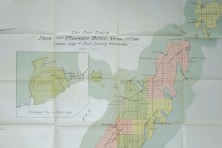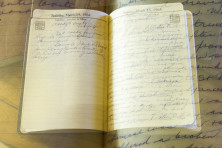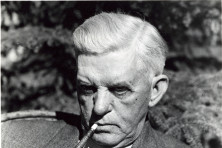Postcard Historian
- Share
- Tweet
- Pin
- Share
Opening my box of memorabilia I find an assortment of postcards. Two from the 1960s of the Wisconsin Dells Ducks sent to me from the boy next door, a postcard stamped from the bottom of the Grand Canyon and a slew of destination postcards from my father’s wanderlust throughout the world. I couldn’t bear to part with the memories and, as it turns out, I don’t need to – I could join one of the hundreds of postcard collectors, known as deltiologists, and collect, study and even trade my cards.
Richard Lauder, formerly of Sturgeon Bay, is a deltiologist who specializes in Door County history. Over the past 40 years, he estimates that he has amassed more than 6,500 postcards of Door County; about 20 percent of what was produced in the county and about 65-70 percent of which date back to the early 1900s, known as the “golden age” of postcards.
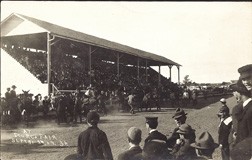
Door County Fair Mule Races, 1909. Postcard from Richard Lauder’s collection.
“Looking at my collection as a whole, I realized that the images and messages held some real history,” he told me in a recent interview.
Lauder’s foray into using the images on postcards and the messages written on them as a way to bring history to life came from watching the Ken Burns documentary on the Civil War [The Civil War: a film by Ken Burns]. Burns used still photographs, music and voice to bring Civil War history to life and give audiences a feel for being in a certain place and time.
“I saw what Ken Burns did with still photographs, music, and voice-overs…and that started me thinking about what I could do with all these cards I was collecting. The potential ability to have more meaning was always just stifled between the book covers that housed them.”
Though Ken Burns sparked Lauder’s imagination about how he could use the postcards, it was actually one of Lauder’s friends and fellow postcard collector that turned the inspiration into a tangible product. When his friend died of brain cancer, his postcard collection, which included cards from photographer Arthur J. Kingsbury of Antigo, Wis. was passed on to Lauder. Kingsbury specialized in photographing Wisconsin in the early 20th century especially the Ojibwa and Menominee Indians in northeast Wisconsin and Michigan’s Upper Peninsula. As a gift to his deceased friend’s family, using the inspiration from Ken Burn’s work, Lauder made his first DVD using the still images from the postcards of his friend’s collection adding voice tracks, sounds and music to bring the history alive.
“It takes a lot of patience. It’s intricate work – adding four layers of soundtrack and blending them together – it truly tries your soul,” he laments.
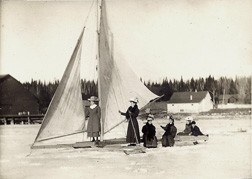
Three Sister Bay women ice boating, 1907. From Richard Lauder’s collection.
The process begins with scanning the images onto a computer. Next is organizing the scenes by location and dates and then doing a fair amount of research into what each scene depicted. He searches the local library archives and past issues of the Door County Advocate. Once those steps are complete and he’s satisfied he’s found all the historical background, he looks for people to record the written messages – trying to match age and gender with the written messages. Then he records sounds of the place. For instance, in his most recent DVD, Yesteryear’s Washington Island, he recorded the sound of ship horns, water, birds – all the sounds that make the place authentic and real. The final step is using an editing program to layer the different sound tracks to create the DVD. The entire process takes him several months.
“I found that I could time-travel through the images to recreate Door County locales dating back over 100 years,” he explained while describing the process. “By adding the twin elements of sound tracks and voices reading their messages along with camera movements to the postcards, it was possible to “bring alive” the static images. From the feedback I’ve received, these DVDs are proving to be unique and valued sources of knowledge of a time too quickly passing from today’s frenzied pace.”
Lauder says most people who develop a passion for postcard collecting start out by finding postcards from their hometown; suddenly they get interested in postcards and are going to postcard shows and postcard clubs, usually focusing on a very particular topic.
“There’s a person who collects only cows standing in water or only cats or ice cream parlors,” Lauder says. “And then there are some very obscure topics like only postcards with images of clam fishing on the Mississippi River or only postcards with images of Ainu Indians from Japan.”
Lauder belongs to the Four Lakes Postcard Club in Madison and travels to various shows looking to add to his Door County collection. The most he’s ever paid for a Door County postcard? $150.
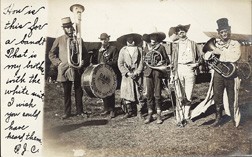
Dubbins Rural Guard Band, Chambers Island. From Richard Lauder’s collection.
He has completed a collection of DVDs on Door County communities including Sturgeon Bay, Fish Creek, Ephraim, Sister Bay, Baileys Harbor/Jacksonport, Clark Lake and, most recently, Washington Island.
Next on his list: Peninsula State Park. “I have approximately 300 postcards from the park, enough to begin,” said Lauder.
Maybe he will even finish in time for National Postcard Week in May.
Richard Lauder can be reached at [email protected].

